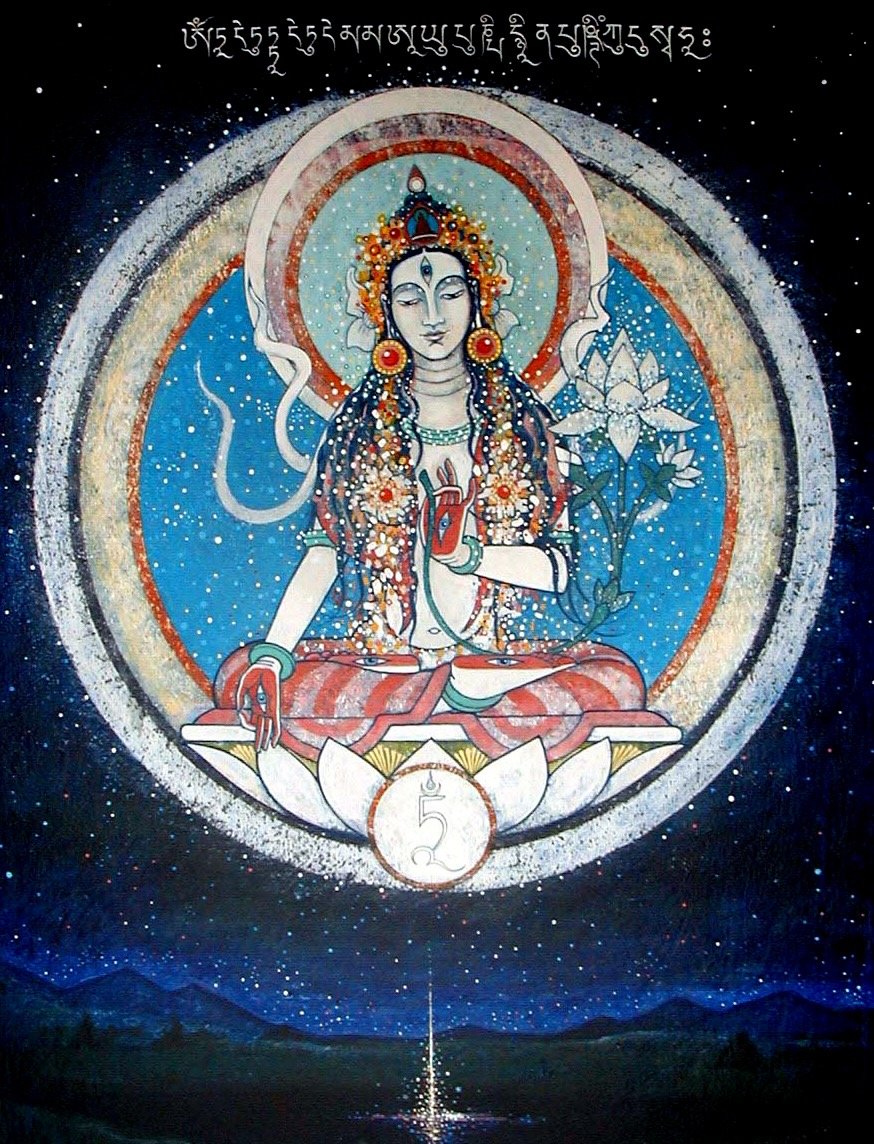Buddhist Figures of Inspiration
In first ten talks of this series Vaddhaka speaks about the Buddha and nine other historical figures from India, Tibet, China and Japan that have inspired him. In the eleventh talk he shifts to an extensive account of the historical origin and development of the inspiring figure of the Bodhisattva. In the twelfth and thirteenth talks Vaddhaka turns to the archetypal figures of Amoghasiddhi and White Tara who are key sources of personal inspiration. In the final talk Vaddhaka relates his personal vision of what enlightenment might be.
For these talks there are transcripts only, except for Amoghasiddhi and White Tara for which there are transcripts and recordings.
- White Tara Painting by Aloka01 The Buddha Shakyamuni and the Nature of Enlightenment
Here Vaddhaka gives his personal appreciation of Shakyamuni. He sees the Buddha as a freethinker, an individual, a radical, a human being, a walker, and above all someone who was kind. He reflects upon different aspects of the nature of the Buddha’s enlightenment, emphasising the mystery at the heart of the Buddha’s experience.
02 Ananda and Mahakassapa: the Romantic and the Stoic
Ananda and Mahakassapa were two of the Buddha’s most senior disciples. They were two very different characters, who were both still alive when the Buddha died, and who played critical parts in the development of Buddhism after the Buddha’s death.
03 Nagarjuna and the Nature of Emptiness
Nagarjuna is often described as the ‘Second Buddha’, because he was the first person after the death of the historical Buddha to present the Dharma in a voice of his own. In particular he took the notion of conditionality or pratitya samutpada and explored it through the notion of emptiness or sunyata and gave it new life.
04 Great Travellers: (i) Atisha and the Gradual Path
In this and the following two sessions Vaddhaka talks about three great Buddhist travellers. The first traveller is Atisha, an Indian Buddhist who helped to establish Buddhism in Tibet, and who elucidated a combined, gradual path.
05 Great Travellers (ii) Xuanzang and the Yogacara School
Here Vaddhaka turns to Xuanzang, famous for his long and dangerous pilgrimage across China to India, and back again, which took sixteen years from 629 to 645. As a practitioner of Buddhism, Xuanzang was particularly interested in the Yogacara school, and Vaddhaka gives us an overview of the teachings of that school.
06 Great Travellers (iii) Dogen and the Cook
Vaddhaka tells us about Dogen, who was the 13th century founder of the Soto Zen school in Japan. Vaddhaka focuses on the famous meeting between Dogen and an old head cook of a Chinese monastery, and on Dogen’s struggles to find an answer to the question that drove him to travel to China: “If all human beings are endowed with Buddha Nature, why is it that one must train oneself so strenuously to gain the Buddha Nature?”
07 Shinran and Other Power
Shinran was another thirteenth century Japanese Buddhist master, the founder of the Jodo Shinshu school of Pure Land Buddhism. Shinran is most well-known for the notion of ‘other power’ (‘tariki’) which he contrasts with self-power (‘jiriki’). Vaddhaka explores what exactly is meant by ‘other power’.
08 Kukai and Pilgrimage
Around the island of Shikoku in Japan is a pilgrimage to Kukai, the ninth century founder of Shingon, the Japanese version of Tantric or Vajrayana Buddhism. With great skills as a scholar, calligrapher, and wood carver, he was also a poet, the author of one of Vaddhaka’s favourite Buddhist poems, which is reproduced at the end of this talk.’
09 Ryokan, the Great Fool, and Poetry
Ryokan is one of the most popular figures in Japanese Buddhist history, known as The Great Fool. Although he could have been the head of a monastery, he was a solitary beggar, living on the fringes of villages and towns, whilst still being an enthusiastic and much-loved participant in village life. He is best known for his poetry.
10 Mahaprajapati, the enlightened nun
Here Vaddhaka talks about three women who feature in the life story of the Buddha; first, Mahaprajapati, the aunt who brought him up and was the first ordained nun in the Buddha’s sangha; second, Kisa Gotami and the story of the mustard seeds; and third, Sujata, whose offering of rice helped give the Buddha-to-be strength to sit and gain enlightenment.
11 The Origin and Development of the Bodhisattva Ideal
Utilising work done by various scholars, but especially Jan Nattier, Vaddhaka describes in extensive detail how the notion of a Bodhisattva developed from the Early Buddhism of the Pali Canon through to the White Lotus Sutra of the Mahayana.
12 Amoghasiddhi: The Sun at Midnight
Vaddhaka gives a personal invocation of the Green Buddha of the North, Amoghasiddhi, in which he reflects upon the northern realm, upon the colour green, and upon the symbolism of the visvavajra, the double vajra.
13 This is the place for White Tara
Vaddhaka talks about his special bond with the female Bodhisattva White Tara. He emphasises White Tara’s seven eyes. For him, the three eyes in the face and forehead represent wisdom and the four eyes in the hands and feet represent a reaching out with the qualities of what we know as the four brahma viharas or four immeasurables of kindness, compassion, appreciative joy, and equanimity.
14 A Personal Vision of the Path to Enlightenment
This talk contains similar material to the talk no.6 in the series “Stories and the Buddha’s Search for Enlightenment”, but it is placed in the context of the wider existential crisis currently facing humanity, as well as an animistic vision of the world and universe as alive.
